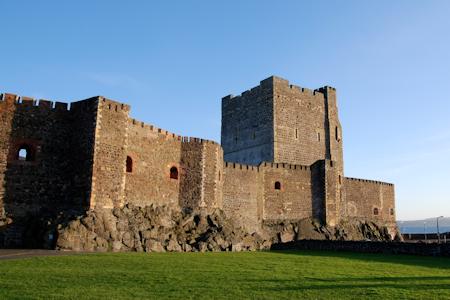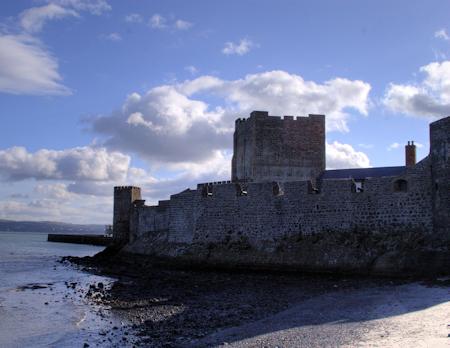
Carrickfergus Castle
Carrickfergus possesses one of Ireland's most impressive fortifications to survive from the Norman period. The castle is an imposing stronghold built on a rocky promontory overlooking Belfast Lough. Carrickfergus castle was started in 1178 by the Anglo-Norman John De Courcy.
The first phase of construction included the inner ward (a polygonal courtyard) along with a now-ruined great hall on its east wall. De Courcy also built the massive stone keep which still dominates the town's skyline.
Carrickfergus Becomes a Royal Castle
John de Courcy didn't hang on to the castle for very long and he was ousted in 1204 by Hugh de Lacy (the son of Hugh de Lacy who built Trim). Hugh de Lacy in turn was kicked out by King John in 1210. King John wanted the castle as a garrison because it was a strong castle in a strategic site. It became the principal administrative and residential centre for the English government in the north of Ireland for much of the Middle Ages.
The second phase of building began in 1216 and it included finishing the great tower and the addition of the middle ward. The middle ward was enclosed by a curtain wall ending in a square tower at the edge of the Lough. The third phase, completed around 1242, included the outer ward and a twin-towered gatehouse with a portcullis to the north.
The north-east of Ulster was much fought-over during the 16th Century when English influence became tenuous. In the 1570's Carrickfergus was the base for a failed English takeover of the province, but by the 1590's the MacDonald clan under Sorley Boy MacDonald ruled most of the surrounding lands.
In 1597 the English governor of Carrickfergus Castle, John Chichester, arranged a meeting with Sorley Boy's nephew James MacSorley MacDonald. At the governor's command the English attacked MacDonald's forces. Chichester was killed during the battle, which the English lost with over 200 killed or wounded.
A second Battle of Carrickfergus took place in 1760 during the Seven Years War. The garrison in the town was overrun by French troops led by Privateer Francois Thurot. He captured the castle and town for five days, holding them to ransom, and menaced nearby Belfast. He was driven out by a large local militia and a Royal Navy squadron.
During the 16th and 17th Centuries improvements were made to allow the addition of artillery. The castle was still attacked and captured on a number of occasions during this time. In 1690, during the Jacobite War in Ireland, General Schomberg beseiged and took the castle and town. Carrickfergus was also where King William III of England (King William of Orange) first landed in Ireland on the 14th June 1690.
A Change of Role
In 1797 the castle, which had been used on occasion to house prisoners of war, became a prison. During subsequent years it became a magazine and armoury. During the First World War the castle was used as a garrison and ordnance store and in the Second World War it was used as an air raid shelter.
The castle was garrisoned continuously for over 7 centuries until 1928 when it was transferred from the British Army to the government of Northern Ireland. Today the castle is owned by Northern Ireland Environment Agency and run as a visitor attraction and historic monument. The castle is one of the best preserved medieval structures in Ireland and it holds numerous exibits on medieval and castle life.
Access to the castle is encouraged, particularly for educational visits, with resources available for teachers and school pupils. The castle's banqueting hall has been fully restored and is available for hire for events and bridal functions and the vaults are available for children's birthday parties.
Status: Museum/Party Venue
Owner: Northern Ireland Enivonment Agency
Tel: 028 9335 1273
Website: www.doeni.gov.uk/niea/places_to_visit_home/historic-monuments/carrick.htm
Opening Times: 10am to 4pm daily


The imposing keep and outer wall.

The wall along the shore.